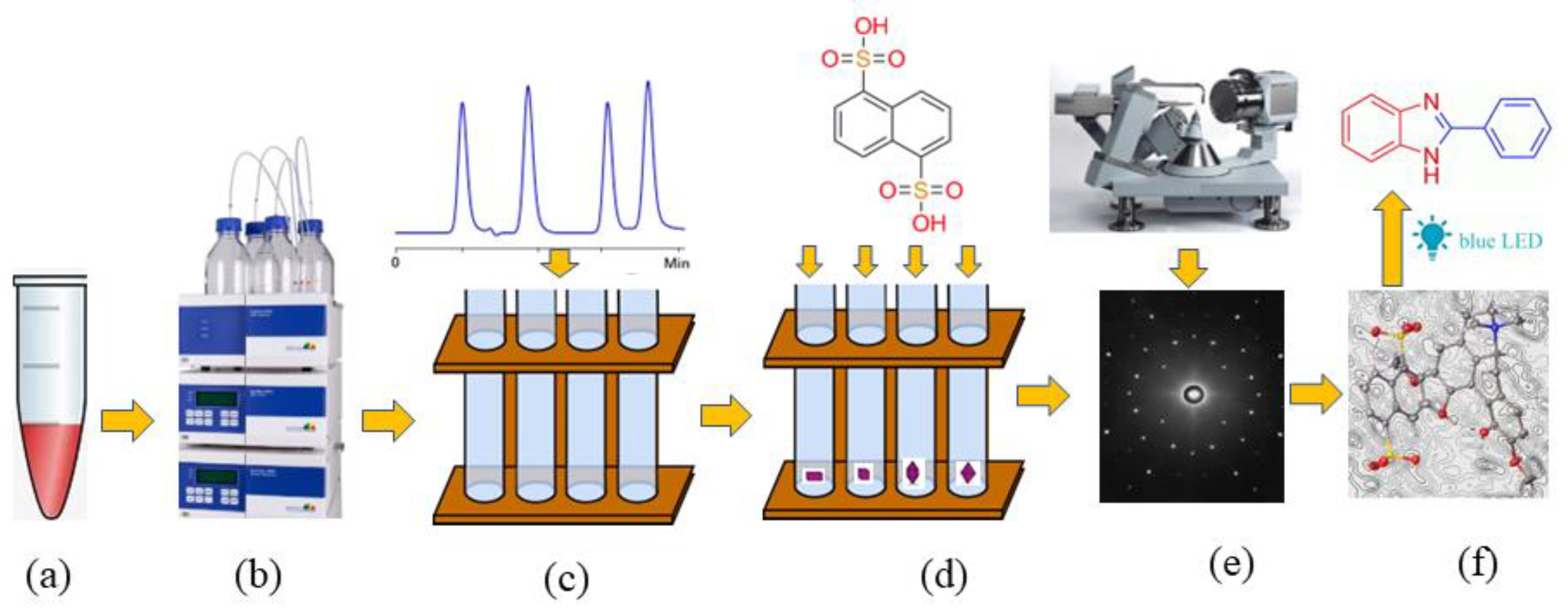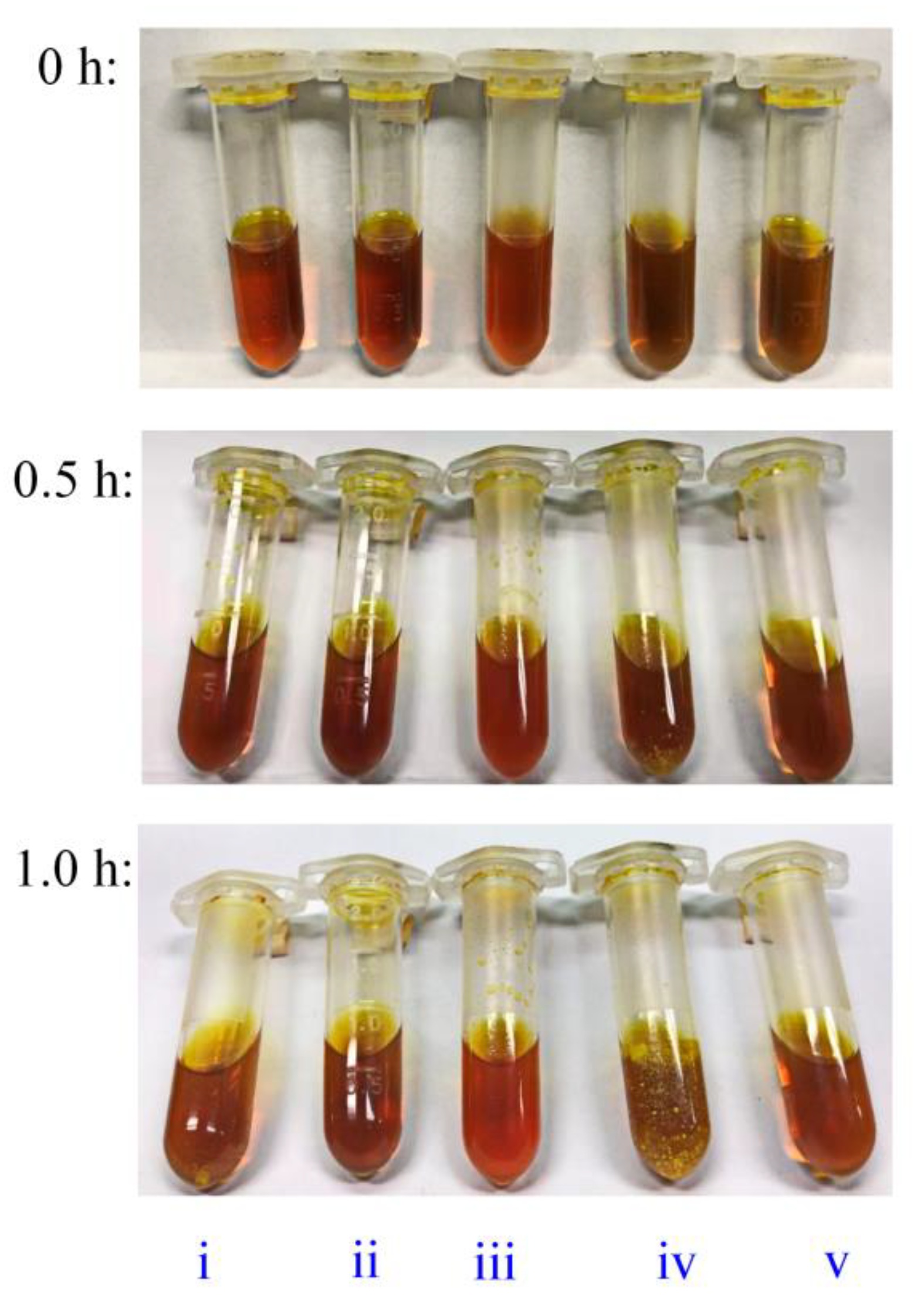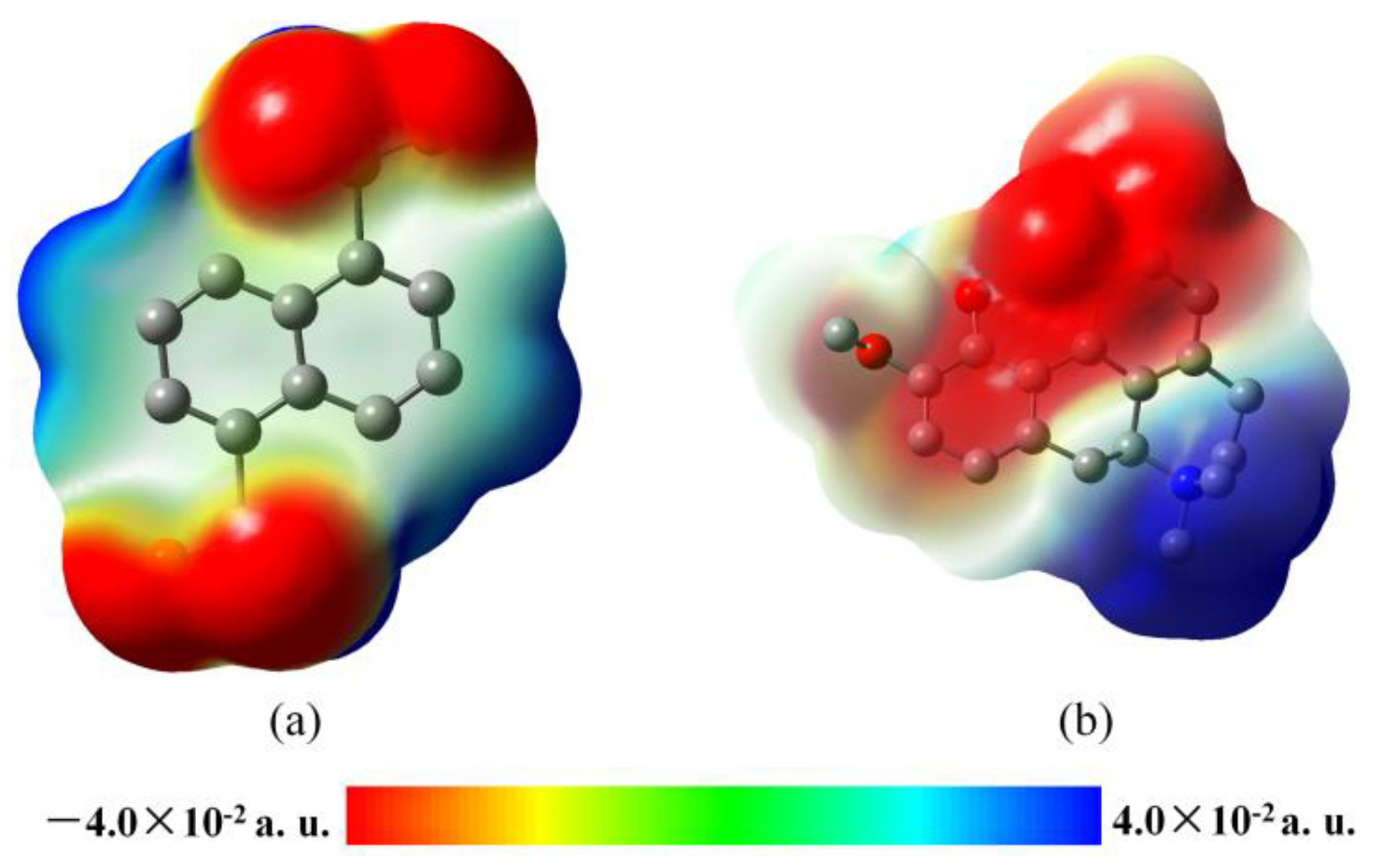Identification of Photocatalytic Alkaloids from Coptidis Rhizome by an Offline HPLC/CC/SCD Approach
Abstract
1. Introduction
2. Results
2.1. Photocatalysis of Benzimidazole Catalysed by the Raw Material and Total Alkaloids under Blue LED Irradiation
2.2. HPLC Analysis of the Total Alkaloid and Prescreening of Coformers
2.3. Identification of the Individual Component by Co-Crystallization
2.4. NDS Decreases the Required Amounts of Alkaloids for Crystallization to Nanoscale
2.5. Photocatalysis by the Individual Alkaloids
3. Discussion
4. Materials and Methods
4.1. Extraction of Total Alkaloids from CR
4.2. Separation of Individual Alkaloids
4.3. Co-Crystallization
4.4. Single-Crystal X-ray Diffraction Analysis
4.5. Electrostatic Potential Surfaces
4.6. Synthesis of Benzimidazole Using CR and the Alkaloids as Catalysts
5. Conclusions
Supplementary Materials
Author Contributions
Funding
Institutional Review Board Statement
Informed Consent Statement
Data Availability Statement
Acknowledgments
Conflicts of Interest
Sample Availability
References
- Paterson, I.; Anderson, E.A. The Renaissance of Natural Products as Drug Candidates. Science 2005, 310, 451–453. [Google Scholar] [CrossRef] [PubMed]
- Harvey, A.; Edrada-Ebel, R.; Quinn, R. The re-emergence of natural products for drug discovery in the genomics era. Nat. Rev. Drug Discov. 2015, 14, 111–129. [Google Scholar] [CrossRef] [PubMed]
- Atanasov, A.G.; Zotchev, S.B.; Dirsch, V.M.; Supuran, C.T. Natural products in drug discovery: Advances and opportunities. Nat. Rev. Drug Discov. 2021, 20, 200–216. [Google Scholar] [CrossRef] [PubMed]
- Chhetri, B.K.; Lavoie, S.; Sweeney-Jones, A.M.; Kubanek, J. Recent trends in the structural revision of natural products. Nat. Prod. Rep. 2018, 35, 514–531. [Google Scholar] [CrossRef]
- Velík, J.; Baliharová, V.; Fink-Gremmels, J.; Bull, S.; Lamka, J.; Skálová, L. Benzimidazole drugs and modulation of biotransformation enzymes. Res. Vet. Sci. 2014, 76, 95–108. [Google Scholar] [CrossRef]
- Kalalbandi, V.K.A.; Seetharamappa, J.; Katrahalli, U.; Bhat, K.G. Synthesis, crystal studies, anti-tuberculosis and cytotoxic studies of 1-[(2E)-3-phenylprop-2-enoyl]-1H-benzimidazole derivatives. Eur. J. Med. Chem. 2014, 79, 194–202. [Google Scholar] [CrossRef]
- Borbaa, P.A.A.; Pinotti, M.; Andradeb, G.R.S.; Costa, N.B., Jr.; Juniord, L.R.O.; Fernandesd, D.; Campose, C.E.M.; Stulzera, H.K. The effect of mechanical grinding on the formation, crystalline changes and dissolution behaviour of the inclusion complex of telmisartan and β-cyclodextrins. Carbohydr. Polym. 2015, 133, 373–383. [Google Scholar] [CrossRef]
- Tahlan, S.; Kumar, S.; Kakkar, S.; Narasimhan, B. Benzimidazole scafolds as promising antiproliferative agents: A review. BMC Chem. 2019, 13, 66. [Google Scholar] [CrossRef]
- Évora, A.O.L.; Bernardes, C.E.S.; Piedade, M.F.M.; Conceição, A.C.L.; Minas da Piedade, M.E. Energetics of Glycine Cocrystal or Salt Formation with Two Regioisomers: Fumaric Acid and Maleic Acid. Cryst. Growth Des. 2019, 19, 5054–5064. [Google Scholar] [CrossRef]
- Alhalaweh, A.; George, S.; Boström, D.; Velaga, S.P. 1:1 and 2:1 Urea−Succinic Acid Cocrystals: Structural Diversity, Solution Chemistry, and Thermodynamic Stability. Cryst. Growth Des. 2010, 10, 4847–4855. [Google Scholar] [CrossRef]
- Darwish, S.; Zeglinski, J.; Krishna, G.R.; Shaikh, R.; Khraisheh, M.; Walker, G.M.; Croker, D.M.A. New 1:1 Drug-Drug Cocrystal of Theophylline and Aspirin: Discovery, Characterization, and Construction of Ternary Phase Diagrams. Cryst. Growth Des. 2018, 18, 7526–7532. [Google Scholar] [CrossRef]
- Okon, E.; Kukula-Koch, W.; Jarzab, A.; Halasa, M.; Stepulak, A.; Wawruszak, A. Advances in Chemistry and Bioactivity of Magnoflorine and Magnoflorine-Containing Extracts. Int. J. Mol. Sci. 2020, 21, 1330. [Google Scholar] [CrossRef] [PubMed]
- Lin, Z.; Li, S.; Guo, P.; Wang, L.; Zheng, L.; Yan, Z.; Chen, X.; Cheng, Z.; Yan, H.; Zheng, C.; et al. Columbamine suppresses hepatocellular carcinoma cells through down regulation of PI3K/AKT, p38 and ERK1/2 MAPK signaling pathways. Life Sci. 2019, 218, 197–204. [Google Scholar] [CrossRef] [PubMed]
- Pooja, M.; Reddy, G.J.; Hema, K.; Dodoala, S.; Koganti, B. Unravelling high-affinity binding compounds towards transmembrane protease serine 2 enzyme in treating SARS-CoV-2 infection using molecular modelling and docking studies. Eur. J. Pharmacol. 2021, 890, 173688. [Google Scholar]
- Tan, L.; Li, C.; Chen, H.; Mo, Z.; Zhou, J.; Liu, Y.; Ma, Z.; Xu, Y.; Yang, X.; Xie, J.; et al. Epiberberine, a natural protoberberine alkaloid, inhibits urease of Helicobacter pylori and jack bean: Susceptibility and mechanism. Eur. J. Pharm. Sci. 2017, 110, 77–86. [Google Scholar] [CrossRef]
- Lang, L.; Hu, Q.; Wang, J.; Liu, Z.; Huang, J.; Lu, W.; Huang, Y. Coptisine, a natural alkaloid from Coptidis Rhizoma, inhibits plasmodium falciparum dihydroorotate dehydrogenase. Chem. Biol. Drug Des. 2018, 92, 1324–1332. [Google Scholar] [CrossRef]
- Friedemann, T.; Schumacher, U.; Tao, Y.; Leung, K.M.; Schröder, S. Neuroprotective Activity of Coptisine from Coptis chinensis (Franch). Evid.-Based Complement. Altern. Med. 2015, 2015, 827308. [Google Scholar] [CrossRef]
- Schmeller, T.; Latz-Brüning, B.; Wink, M. Biochemical activities of berberine, palmatine and sanguinarine mediating chemical defence against microorganisms and herbivores. Phytochemistry 1997, 44, 257–266. [Google Scholar] [CrossRef]
- Akhtar, W.; Khan, M.F.; Verma, G.; Shaquiquzzaman, M.; Rizvi, M.A.; Mehdi, S.H.; Akhter, M.; Alam, M.M. Therapeutic evolution of benzimidazole derivatives in the last quinquennial period. Eur. J. Med. Chem. 2017, 126, 705–753. [Google Scholar] [CrossRef]
- Duan, L.; Li, Q.; Wu, N.; Xu, D.; Zang, H. Synthesis of 2,5-disubstitued benzimidazole using SnCl2-catalyzed reduction system at room temperature. Chin. Chem. Lett. 2014, 25, 155–158. [Google Scholar] [CrossRef]
- Sun, N.; Qi, D.; Jin, Y.; Wang, H.; Wang, C.; Qu, C.; Liu, J.; Jin, Y.; Zhang, W.; Jiang, J. Porous Pyrene Organic Cage with Unusual Absorption Bathochromic-Shift Enables Visible Light Photocatalysis. CCS Chem. 2021, 3, 2917–2925. [Google Scholar] [CrossRef]
- Li, Z.; Song, H.; Guo, R.; Zuo, M.; Hou, C.; Sun, S. Visible-light-induced condensation cyclization to synthesize benzimidazoles using fluorescein as a photocatalyst. Green Chem. 2019, 21, 3602. [Google Scholar] [CrossRef]
- Zhang, X.; Sun, X.; Wu, J.; Wu, Y.; Wang, Y.; Hu, X.; Wang, X. Berberine Damages the Cell Surface of Methicillin-Resistant Staphylococcus aureus. Front. Microbiol. 2020, 11, 621. [Google Scholar] [CrossRef] [PubMed]
- Pmo, A.; Tzl, B.; Act, C.; Pr, B.; Mfc, B. Effect of berberine associated with photodynamic therapy in cell lines. Photodiagn. Photodyn. 2020, 32, 02045. [Google Scholar]
- Jantová, S.; Letasiova, S.; Brezova, V.; Cipak, L.; Labaj, J. Photochemical and phototoxic activity of berberine on murine fibroblast NIH-3T3 and Ehrlich ascites carcinoma cells. J. Photochem. Photobiol. B 2006, 85, 163–176. [Google Scholar] [CrossRef]
- Qi, F.; Sun, Y.; Lv, M.; Qin, F.; Cao, W.; Bi, L. Effects of palmatine hydrochloride mediated photodynamic therapy on oral squamous cell carcinoma. Photochem. Photobiol. Sci. 2019, 18, 1596–1605. [Google Scholar] [CrossRef]
- Barrow, S.J.; Kasera, S.; Rowland, M.J.; Bamo, J.D.; Scheman, O.A. Cucurbituril-Based Molecular Recognition. Chem. Rev. 2015, 115, 12302–12406. [Google Scholar] [CrossRef]
- Swartjes, A.; White, P.B.; Lammertink, M.; Elemans, J.; Nolte, R. Host-Guest Exchange of viologen guests in porphyrin cage compounds as studied by selective exchange spectroscopy (1D EXSY) NMR. Angew. Chem. Int. Ed. Engl. 2021, 133, 1274–1282. [Google Scholar] [CrossRef]
- Wang, S.; Huang, Z.; Li, A.; Zhao, Y.; Zuo, W.; Li, Y.; Miao, H.; Ma, J.; Sun, W.; Wang, X.; et al. Crown Ether Functionalized Potassium-Responsive Anionocages for Cascaded Guest Delivery. Angew. Chem. Int. Ed. Engl. 2021, 60, 9573–9579. [Google Scholar] [CrossRef]
- Rebek, J., Jr. Host–guest chemistry of calixarene capsules. Chem. Commun. 2000, 8, 637–643. [Google Scholar] [CrossRef]
- Wankar, J.; Kotla, N.G.; Gera, S.; Rasala, S.; Pandit, A.; Rochev, Y.A. Recent Advances in Host–Guest Self-Assembled Cyclodextrin Carriers: Implications for Responsive Drug Delivery and Biomedical Engineering. Adv. Funct. Mater. 2020, 30, 1909049. [Google Scholar] [CrossRef]
- Abeysekera, A.M.; Sinha, A.S.; Aakeroy, C.B. The Impact of Halogen Substituents on the Synthesis and Structure of Co-Crystals of Pyridine Amides. Molecules 2021, 26, 1147. [Google Scholar] [CrossRef] [PubMed]
- Lou, Y.; Yu, K.; Wu, X.; Wang, Z.; Cui, Y.; Bao, H.; Wang, J.W.; Hu, X.R.; Ji, Y.X.; Tang, G. Co-Crystals of Resveratrol and Polydatin with L-Proline: Crystal Structures, Dissolution Properties, and In Vitro Cytotoxicities. Molecules 2021, 26, 5722. [Google Scholar] [CrossRef]
- Giliopoulos, D.; Zamboulis, A.; Giannakoudakis, D.; Bikiaris, D.; Triantafyllidis, K. Polymer/metal organic framework (MOF) nanocomposites for biomedical applications. Molecules 2020, 25, 185. [Google Scholar] [CrossRef]
- Jiang, X.; Yu, H.; Shi, J.; Bai, Q.; Xu, Y.; Zhang, Z.; Hao, X.Q.; Li, B.; Wang, P.; Wu, L.; et al. From Mechanically Interlocked Structures to Host–Guest Chemistry Based on Twisted Dimeric Architectures by Adjusting Space Constraints. CCS Chem. 2021, 3, 2042–2054. [Google Scholar] [CrossRef]
- Li, Y.; Tang, S.; Yusov, A.; Rose, J.; Borrfors, A.N.; Hu, C.T.; Ward, M.D. Hydrogen-bonded frameworks for molecular structure determination. Nat. Commun. 2019, 10, 4477. [Google Scholar] [CrossRef] [PubMed]
- Inokuma, Y.; Yoshioka, S.; Ariyoshi, J.; Arai, T.; Hitora, Y.; Takada, K.; Matsunaga, S.; Rissanen, K.; Fujita, M. X-ray analysis on the nanogram to microgram scale using porous complexes. Nature 2013, 495, 461–466. [Google Scholar] [CrossRef]
- Lee, S.; Kapustin, E.A.; Yaghi, O.M. Coordinative alignment of molecules in chiral metal-organic frameworks. Science 2016, 353, 808. [Google Scholar] [CrossRef]
- Chen, C.; Di, Z.; Li, H.; Liu, J.; Wu, M.; Hong, M. An ultrastable π–π Stacked Porous Organic Molecular Framework as a Crystalline Sponge for Rapid Molecular Structure Determination. CCS Chem. 2021, 3, 1352–1362. [Google Scholar] [CrossRef]
- Wei, D.G.; Wilson, W.D.; Neidle, S. Small-molecule binding to the DNA minor groove is mediated by a conserved water cluster. J. Am. Chem. Soc. 2013, 135, 1369–1377. [Google Scholar] [CrossRef]








| Entry | Photocatalyst (3%) | Time (h) | Conditions | Yield b (%) |
|---|---|---|---|---|
| 1 | CR | 2 h | 470 nm | Trace |
| 2 c | CR | 12 h | - | Trace |
| 3 d | - | 12 h | 470 nm | Trace |
| 4 | CR | 12 h | 470 nm | 43.4 |
| 5 | Total alkaloids | 12 h | 470 nm | 58.2 |
| 6 | Magnolflorine (1) | 12 h | 470 nm | 54.6 |
| 7 | Columbamine (2) | 12 h | 470 nm | 82.1 |
| 8 | Jatrorrhizine (3) | 12 h | 470 nm | 73.3 |
| 9 | Epiberberine (4) | 12 h | 470 nm | 82.1 |
| 10 | Coptisine (5) | 12 h | 470 nm | 62.3 |
| 11 | Palmatine (6) | 12 h | 470 nm | 71.2 |
| 12 | Berberine (7) | 12 h | 470 nm | 73.6 |
| δ/ppm | NDS | NDS ⊃ 12 | NDS ⊃ 22 | (NDS)1/2 ⊃ 3 | (NDS)1/2 ⊃ 4 | NDS ⊃ 52 | (NDS)1/2 ⊃ 6 | (NDS)1/2 ⊃ 7 | |
|---|---|---|---|---|---|---|---|---|---|
| NDS | a | 7.98 | 7.93(−0.05) | 7.92(−0.06) | 7.92(−0.06) | 7.91(−0.07) | 7.92(−0.06) | 7.91(−0.07) | 7.92(−0.06) |
| b | 7.49 | 7.42(−0.07) | 7.41(−0.08) | 7.41(−0.08) | 7.41(−0.08) | 7.41(−0.08) | 7.39(−0.10) | 7.40(−0.09) | |
| c | 8.88 | 8.87(−0.01) | 8.86(−0.02) | 8.86(−0.02) | 8.86(−0.02) | 8.86(−0.02) | 8.85(−0.03) | 8.86(−0.02) |
| Items | NDS ⊃ 12 | NDS ⊃ 22 | (NDS)1/2 ⊃ 3 | (NDS)1/2 ⊃ 4 | NDS ⊃ 52 | (NDS)1/2 ⊃ 6 | (NDS)1/2 ⊃ 7 |
|---|---|---|---|---|---|---|---|
| Formula | C10H6O6S2, 2(C20H24NO4), CH4O, 2(H2O) | C10H6O6S2, 2(C20H20NO4), 2(CH4O) | C5H3O3S, C20H20NO4 | C5H3O3S, C20H18NO4 | C10H6O6S2, 2(C19H14NO4) | C10H6O6S2, 2(C21H22NO4) | C10H6O6S2, 2(C20H18NO4) |
| Mw [gmol−1] | 1039.14 | 1027.09 | 481.50 | 479.49 | 926.89 | 991.06 | 479.49 |
| System | triclinic | monoclinic | monoclinic | triclinic | triclinic | triclinic | triclinic |
| Space group | P1 | Cc | P21/n | P-1 | P-1 | P-1 | P-1 |
| a(Å) | 10.9669(7) | 12.0470(4) | 14.3561(5) | 9.2880(9) | 6.7985(3) | 7.3194(3) | 7.3159(4) |
| b(Å) | 11.0345(7) | 21.3470(6) | 7.1689(2) | 10.6480 (9) | 15.4959(8) | 12.5231(6) | 11.3649(6) |
| c(Å) | 12.7760(8) | 18.2115(5) | 21.2493(8) | 12.2878 (12) | 19.8126(9) | 14.2025(7) | 14.0441(8) |
| α(°) | 67.778(6) | 90 | 90 | 76.056(8) | 94.084(4) | 103.042(4) | 66.555(5) |
| β(°) | 64.965(6) | 93.338(3) | 105.325(4) | 76.398(8) | 97.720(3) | 104.921(4) | 88.456(5) |
| γ(°) | 88.765(5) | 90 | 90 | 88.900(8) | 91.639(4) | 106.169(4) | 77.854(5) |
| V(Å3) | 1278.9(1) | 4675.5(2) | 2109.1(1) | 1145.4(1) | 2061.5(1) | 1144.4(1 | 1045.2(1) |
| Z | 1 | 4 | 4 | 2 | 2 | 1 | 2 |
| dcalcd [mg/cm3] | 1.349 | 1.459 | 1.516 | 1.390 | 1.493 | 1.438 | 1.524 |
| Rint | 0.0319 | 0.0313 | 0.0380 | 0.0460 | 0.0406 | 0.0270 | 0.0728 |
| GooF | 1.033 | 1.051 | 1.054 | 1.044 | 1.016 | 1.073 | 1.038 |
| Temperature (K) | 150.00(10) | 150.00(10) | 150.00(10) | 150.00(10) | 150.00(10) | 150.00(10) | 150.00(10) |
| R1 [I > 2σ(I)] | 0.0436 | 0.0426 | 0.0459 | 0.0471 | 0.0550 | 0.0420 | 0.0624 |
| wR2(all data) | 0.1251 | 0.1146 | 0.1233 | 0.1236 | 0.1473 | 0.1124 | 0.1772 |
| F(000) | 550.0 | 2160.0 | 1008.0 | 500.0 | 960.0 | 520.0 | 250.0 |
| CCDC No. | 2097760 | 2097761 | 2097762 | 2097763 | 2097764 | 2097765 | 2097766 |
Publisher’s Note: MDPI stays neutral with regard to jurisdictional claims in published maps and institutional affiliations. |
© 2022 by the authors. Licensee MDPI, Basel, Switzerland. This article is an open access article distributed under the terms and conditions of the Creative Commons Attribution (CC BY) license (https://creativecommons.org/licenses/by/4.0/).
Share and Cite
Qin, S.-Q.; Ma, J.; Wang, Q.-Q.; Xu, W.; Ye, W.-C.; Jiang, R.-W. Identification of Photocatalytic Alkaloids from Coptidis Rhizome by an Offline HPLC/CC/SCD Approach. Molecules 2022, 27, 6179. https://doi.org/10.3390/molecules27196179
Qin S-Q, Ma J, Wang Q-Q, Xu W, Ye W-C, Jiang R-W. Identification of Photocatalytic Alkaloids from Coptidis Rhizome by an Offline HPLC/CC/SCD Approach. Molecules. 2022; 27(19):6179. https://doi.org/10.3390/molecules27196179
Chicago/Turabian StyleQin, Shu-Qin, Jun Ma, Qi-Qi Wang, Wei Xu, Wen-Cai Ye, and Ren-Wang Jiang. 2022. "Identification of Photocatalytic Alkaloids from Coptidis Rhizome by an Offline HPLC/CC/SCD Approach" Molecules 27, no. 19: 6179. https://doi.org/10.3390/molecules27196179
APA StyleQin, S.-Q., Ma, J., Wang, Q.-Q., Xu, W., Ye, W.-C., & Jiang, R.-W. (2022). Identification of Photocatalytic Alkaloids from Coptidis Rhizome by an Offline HPLC/CC/SCD Approach. Molecules, 27(19), 6179. https://doi.org/10.3390/molecules27196179






